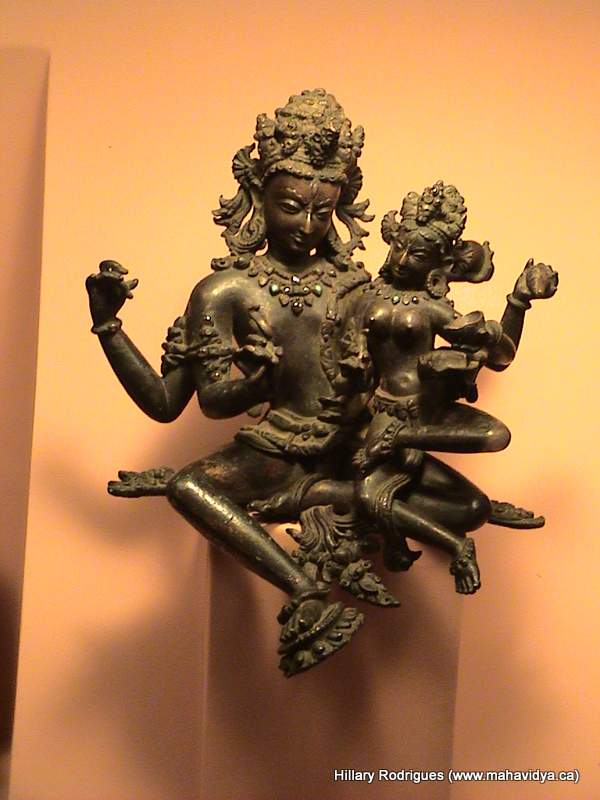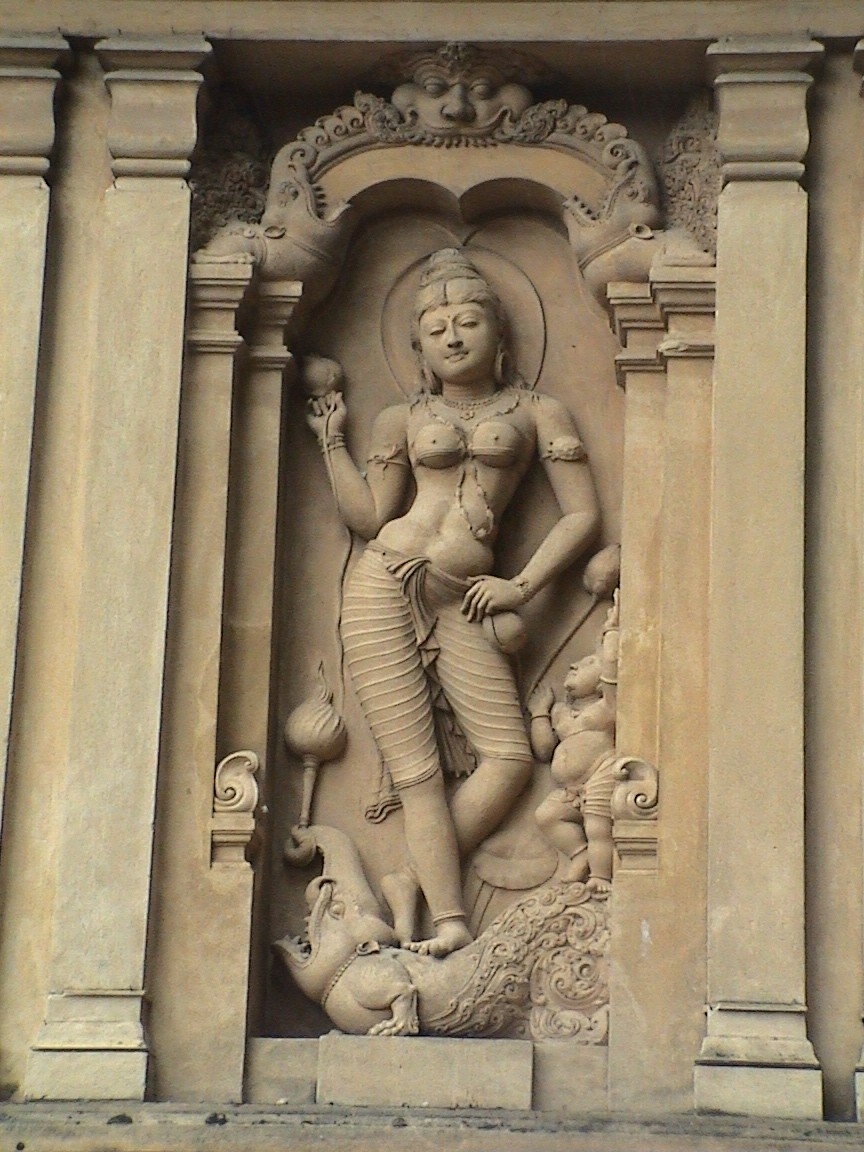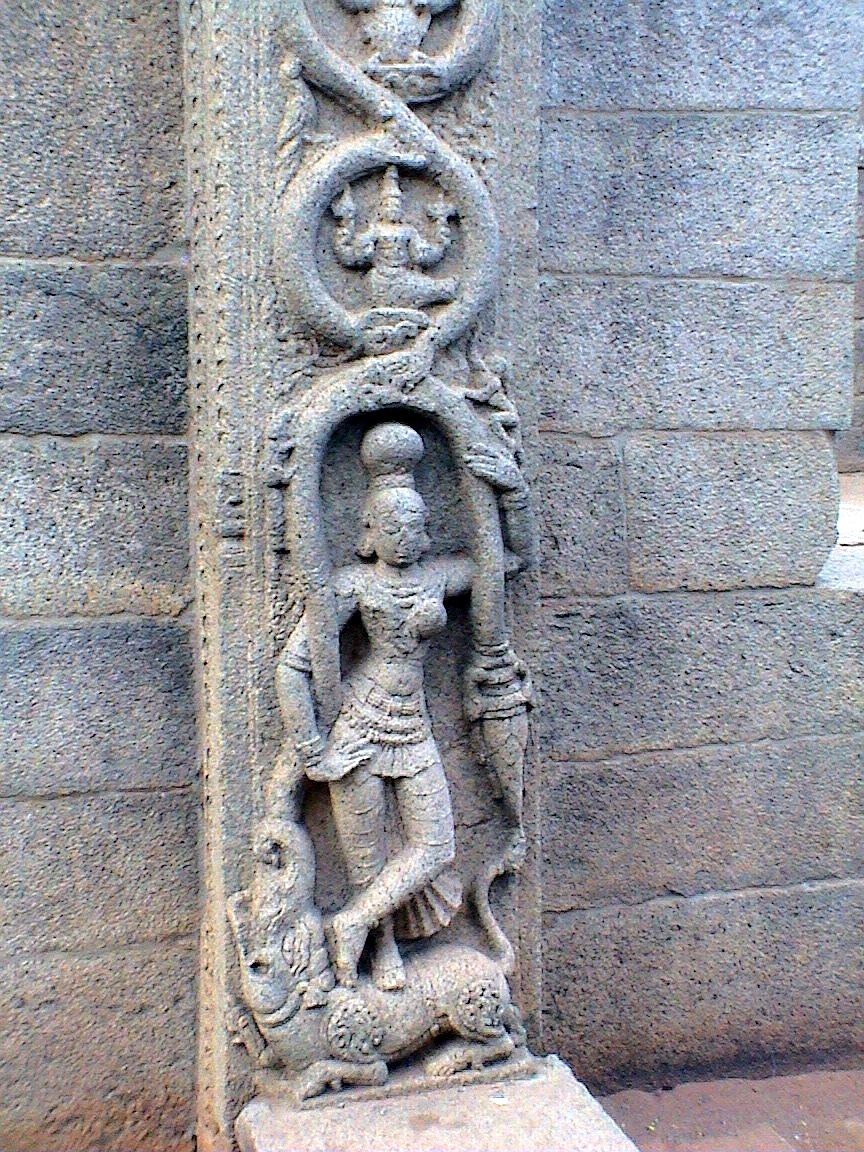Sitala is one of the many Hindu mother goddesses who are known for their benevolence and dangerousness. She is worshipped throughout the Indian subcontinent and is especially adored in the region of Bengal (Stewart 389). Sitala is commonly known as the goddess of smallpox and disease but may also be referred to as the Queen of Disease (Roga Raja), Lord of Pestilence (Vyadhi Pati), or Mother of Poxes (Basenta Raya) (Stewart 389). Her name means the “Cool One” which is thought to be derived from her mythical birth from the cooled ashes of the sacrificial fire (Stewart 390). The smallpox disease, which is now thought to be eradicated, was first identified with Sitala around the 16th century CE, although the smallpox disease was already present in India for hundreds of years prior to this (Rodrigues 329). Sitala is worshipped across different regions of India but mainly in West Bengal, Northern India and the state of Gujarat (Wadley 33). The three regions have different views about Sitala but all are linked by a few common ideas. Sitala is always the “Cool One” and she is frequently represented by a golden pot, except in wealthy temples where she is depicted as a naked women with her hair disheveled, riding a donkey, and wielding a broom (Rodrigues 329).
Sitala is most well known in West Bengal where there are many temples and mangals, which are lengthy poems written in her honor. Throughout West Bengal she is associated with Jvarasur, the Fever Demon, and Raktabati, the one that possess the blood of servant women (Wadley 37). Sitala is worshipped during Phalgun which are the months of February to March. Krsnastami is seen by the Bengali almanac as the proper day of worship although only a few households hold pujas on this day due to the cost. Villages organize collective pujas according to the finances of the village, as well as the availability of performers that are needed to recite the mangals (Wadley 37). Sitala’s main association in Bengal is with the various forms of pox. The origin of worship of Sitala in this region was thought to come from a popular story about a kingdom that was infected with the smallpox disease. Sitala went in disguised as a beautiful woman to see the king and advised him to worship her. The people of the kingdom worshipped her and were relieved of the dreadful smallpox disease (Misra 135).
In Northern India Sitala, is associated with pox but she is also seen as the protector of children (Wadley 41). It is claimed that in a previous life Sitala was married to a Muslim emperor and was very faithful and devoted to the Hindu gods and goddesses, who was deified as Sitala in reward (Misra 135). She is worshipped during Caitra which is in the months of March and April or Baisakh the months of April and May because these months are in the hot season when the outbreak of the disease is the most prevalent. In North India Sitala is associated with stale or leftover food because she is thought to have been born of the cold ashes of the sacrificial fire. Festivals are held in her honor and are commonly termed basora which literally means “Leftover Food Worship” (Wadley 42). The people of this region prepare only cold foods on the day before the pujas and offer these to Sitala and eat only cold food themselves.
The third region, which worships Sitala is the state of Gujarat, where she is no longer associated with disease; instead she is seen as the giver of good fortune, husbands and sons (Wadley 42). The origin of the Sitala shrine in Gujarat is thought to be identified with Bariha Bapji or Babribahan of the Mahabharata (Misra 135). In this region she is not worshipped during the hot season but rather during the rainy season, Shravan, the months of July and August. In much of the literature from this area Sitala is often seen as being associated with Balia Kaka, the powerful uncle who was also worshipped when there was an outbreak of the smallpox disease (Wadley 42).
Although there are vast differences between these three regions and the ways in which they worship this goddess, there are a few similarities that link the regions together. All three of these regions believe that Sitala has seven sisters and may also have one brother who is not as well known. Sitala’s sisters are known as Masani, Basanti, Maha Mati, Polamde, Lamkaria, and Agwani and are all associated with one of the seven types of fevers that are prevalent in this regions.
Unlike many other goddesses, such as Parvati or Laksmi, who are usually linked with other male deities, Sitala does not have a consort (Rodrigues 280). Sitala is worshipped by all classes but she tends to get the most patronage from the poor. Although Sitala, as a mother goddess, is expected to nurture the people of India, she is usually worshipped to avoid her wrath. She is prone to anger and quick to offend any individual who disrupts the balance of hot and cold in their life or body (Wadley 45). It is believed that when this occurs she is provoked and will visit that individual leaving her mark of pox upon their body. The mark that she leaves on the body of infected individuals is often referred to as mayera daya or the grace of the mother (Stewart 390). Many faithful and devoted individuals have come to suffer from her wrath, which can be very hard to explain (Stewart 390). Some sources say that this attention is because these individuals attract her attention through the sacrifices, which causes her to want to visit these individuals in person (Stewart 390). It is said that the person who is infected with the smallpox disease becomes the abode of Sitala.
When an individual is affected by her disease many steps are taken to help that person recover, which often includes further worship to Sitala. An idol that represents Sitala is made out of the earth or cow dung and then is bathed by a holy man and the water is then given to the sick individual. Often the holy man will recite a Sitalastaka, a verse in Sanskrit which praises Sitala. When there is an individual in the house that is ill the other members of the household do not shave, there is to be no sexual intercourse, the women do not comb their hair and any women who is menstruating is not allowed to visit (Misra 136). It is thought that Sitala’s efficacy coordinated the inoculation of smallpox which produced lifelong immunity from the disease. In order for an individual to be treated at one of the many shrines of Sitala, they first had to hold a nam – rakha which is a naming of the disease ceremony. This ceremony involved taking raw sugar and placing it underneath a table where pitchers of water are placed and then a song is chanted to declare that the disease was in fact smallpox (Minsky 166). The inoculation procedure entailed scarifying an area of skin usually just above the wrist and rubbing in a paste that contained water and dried attenuated smallpox crusts (Minsky 167). Priests often would oversee the procedure if it took place at a Sitala shrine but some practiced inoculation themselves. The Priests that preside at these temples are seldom Brahmin. To ensure that the disease does not spread the individuals were placed in quarantine for twenty one days until the infectious period was over and the crusts began to fall off. The pox crusts were then collected and offered in thanks to Sitala (Minsky 167). Through these processes of inoculation the smallpox disease was seemingly eradicated.
Although the smallpox disease is thought to be eradicated the worship of Sitala still continues and this is seen as the reason why, in some regions, she has taken on different personalities that depict her as not only the goddess of disease but also the protector of children and giver of good fortune (Wadley 45). Another reason that Sitala is associated with so many different personalities is because of the changing modes of transmission of traditions and cultural practices among the Hindu religion (Wadley 34).
Bibliography
Minsky, Lauren (2009) “Pursuing Protection from Disease: The Making of Smallpox Prophylactic Practice in Colonial Punjab”. Bulletin of the History of Medicine, vol.83, No.1, pp. 164-190.
Misra, Bhabagrahi (1969) “Sitala: The Smallpox Goddess of India”. Asian Folklore Studies, vol.28, No. 2, pp. 133-142.
Rodrigues, Hillary (2006) Hinduism The eBook: An Online Introduction. Journal of Buddhist Ethics Online Books, Ltd.
Stewart, Tony (1995) Encountering the Smallpox Goddess: The Auspicious Song of Sitala. Princeton, N.J.: Princeton University Press.
Wadley, Susan (1980) “Sitala: The Cool One”. Asian Folklore Studies, vol.39, No. 1, pp. 33-62.
Related Topics
Masan
Basanti
Maha
Mati
Polamde
Lamkaria
Agwani
Jvarasur
Raktabati
Kali
Puja
Blood Sacrifice
Devi
Laksmi
Parvati
Related Websites
http://en.wikipedia.org/wiki/Shitala_Devi
http://www.suite101.com/article.cfm/woman_in_india/47978
http://reli350.vassar.edu/trover/sitala.html
http://www.icsi.berkeley.edu/~snarayan/anthro-pap/subsection3_4_3.html
http://www.sanatansociety.org/hindu_gods_and_goddesses.htm
Article written by: Kaitlyn Erickson (April 2010) who is solely responsible for its content.












